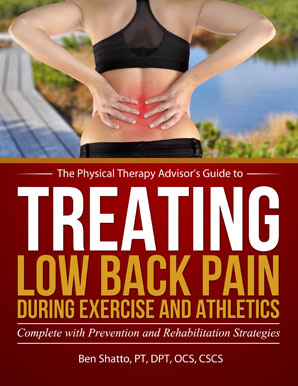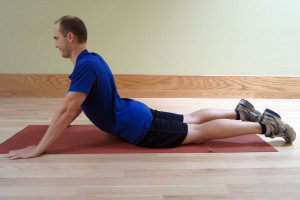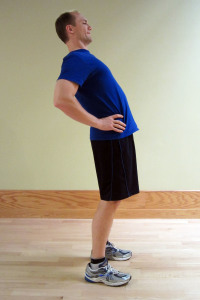Did you know that an estimated $50 billion dollars is spent annually on back pain related issues? Low back pain (LBP) is one of the most prevalent medical conditions treated in the United States and throughout the western world. It affects nearly 80% of the U.S. population at one time or another. It’s one of the top reasons for physician visits and one of the most common reasons for missed work days. The previous post, 12 Sure Fire Ways to Injure Your Back, addressed potential risk factors for low back pain. This follow-up post includes how to safely self-treat your low back pain and helpful methods for a speedy recovery. (Not to mention, possibly saving you time and money by avoiding a physician visit for minor pain!)
To safely self-treat your low back pain, first take a moment to assess your symptoms and pain level. What led to your pain and/or injury? Did the pain come on suddenly or slowly? Evaluate the severity of the injury. If you’re experiencing any of the following, please seek immediate medical attention:
- Loss of bowel/bladder function.
- Uncontrollable pain. The pain is so severe you cannot function or move.
- You are losing muscle function or control. The muscles in the legs will no longer work. (This is different than pain preventing the muscle from working.) This sensation of paralysis occurs when the muscles will not actually function.
- Significant loss of sensation in the leg or groin area. This is not a tingling sensation, but an actual loss of sensation. For example, you cannot feel the toilet paper when you wipe after using the toilet.
- Onset of pain without any known mechanism for the injury. (Thoroughly consider your activity. Many times, a slow onset of pain begins several hours after performing an activity.)
Fortunately, most LBP is mechanical–meaning it is from a physical or structural cause and isn’t related to conditions such as cancer or infections. Most LBP will have a directional preference for extension. A majority of injuries occur when performing a forward biased (flexed movement) like chronic slouching or a spinal flexion biased movement. For discussion purposes, I will be addressing an extension biased program.
You should be able to alter and change your LBP within a short period of time. First, establish a directional preference by identifying a pattern to the pain. Does the pain get worse when you bend over or does it improve? What happens when you repeat this movement? Determine how your pain responds. If it spreads away from the spine and down into the leg, beware that you are moving in the wrong direction. Stop that particular movement, and instead try flexion biased movements. In my experience, most episodes of LBP tend to respond better to extension biased movements. If flexion or extension doesn’t help or change the pain in any way, then you may need assistance from a medical provider.
The rule of thumb for movement: If the pain worsens by spreading peripherally down the buttock and into the leg and/or foot, then the condition is worsening. We must stop that activity. If the pain centralizes and returns back toward the spine (even if the pain worsens slightly), then keep moving as the condition is actually improving. For a thorough discussion and an excellent treatment resource, please refer to Treat Your Own Back by Robin A. McKenzie.
Although most LBP isn’t considered serious, the pain tends to re-occur. One major reason for this is that the deep stabilizing muscles known as the multifidus muscles reflexively shrink, weaken, and lose function. Without proper rehabilitation, the muscles will not fully recover. This increases the risk of future episodes because the spine no longer has the ability to stabilize itself normally.
How to Safely Self-Treat Low Back Pain:
- Perform Press-ups – Once you have injured your back, immediately start press-ups. Perform this exercise with high repetitions and frequently throughout the day as long as the pain does not periperalize down the buttock and into the leg and/or foot. Lie on your stomach and perform 10-20 press-ups. Move slow and easy, but work your way up to full motion multiple times a day.
- Perform Standing Back Extensions – After sitting, stand up and perform standing back extensions. Ideally, perform this exercise at least 10 repetitions each time you stand.
- Activate the Multifidus – Start exercises to activate the multifidus muscles as soon as possible. Think spine extensor muscle activation. Again, perform this exercise frequently during the day after the initial injury. The Lumbar Extensor Exercises are designed to progressively activate the multifidus muscles (with the final exercise being the most challenging). Once the pain subsides and muscle function improves, more advanced lumbar extension strengthening and stabilizing exercises should be performed to decrease your risk of re-current low back pain.
- Don’t Sit – Walking is critical to your recovery! It’s the number one way your spine receives nutrients and disposes of metabolic waste products. Walk frequently, and try to avoid any prolonged sitting.
- If you Sit, Use Good Posture – Use a McKenzie Lumbar Roll to help insure a good lumbar curve. If you can’t sit comfortably, listen to your body and don’t sit! Be sure to stand up and walk every 20-30 minutes. Make sure you stand with good posture as well.
- Stretch the Muscles of the Legs and Pelvis – Hamstring, Hip Flexor, and Piriformis Stretches for LBP help to reduce muscle spasms and tightness throughout pelvis area when performed daily. Stretch for at least 30 seconds at a time, 2-3 times each session.
- Reduce Inflammation and Support the Healing Response – I recommend starting a thirty day course of CapraFlex by Mt. Capra. CapraFlex is an organic glucosamine and chondroitin supplement which also includes an herbal and spice formulation designed to naturally decrease inflammation and support healing. I recommend it to anyone recovering from an injury or attempting to prevent injury when performing at a very high level. I personally use it, and in my practice, it has helped clients recover faster and prevent injury. It can interfere with some blood thinning medication, so if you are on this type of medication, please check with your physician.
- Ice as Needed for Pain – The rule for icing is to apply ice no more than twenty minutes per hour. Do not place the ice directly against the skin, especially if you are using a gel pack style. Individuals with poor circulation or impaired sensation should take particular care when icing.
- Use Topical Analgesics for Pain – There are many topical agents which can be used for pain. My two favorites to help manage pain and stiffness are Arnica Montana (an herbal rub) and Biofreeze.
- Be as Active as You Can – Don’t stop moving! It’s important that you remain as active as you can. You should taper certain activities that you know will increase your pain. This typically would be activities involving heavy loading of the spine such as squats with weight, deadlifts, and other activities that may cause forward flexion (particularly under a load). As you are able to, continue to work on cardiovascular conditioning and core muscle activation, particularly the lumbar extension exercises. Remember the concept of peripheralization and centralization. If your pain progresses from the area of the injury into your leg, then you need to stop that activity. If the pain remains constant or is progressing out of the leg, then continue with the activity as you are helping the body to heal.
- Ask for Help – Yes, even physical therapists have to ask for help sometimes! Many useful manual techniques can help to manage LBP. You just can’t perform them on yourself. If your pain is not improving, I highly suggest seeking a qualified and competent physical therapist who works with clients suffering from LBP. The American Physical Therapy Association offers a wonderful resource to help find a physical therapist in your area. In most states, you can seek physical therapy advice without a medical doctor’s referral (although it may be a good idea to seek your physician’s opinion as well).
Low back pain is a serious and debilitating condition. It will either most certainly affect you or someone close to you. Be pro-active in maintaining a healthy back by incorporating these helpful methods for a speedy recovery. Don’t let LBP affect your ability to stay active and keep enjoying your favorite activities!

AVAILABLE NOW ON AMAZON!
In my book, Treating Low Back Pain during Exercise and Athletics, you will learn how to address specific causes of LBP as well as the best practices on how to prevent and self-treat when you experience an episode of LBP. In this step-by-step LBP rehabilitation guide (complete with photos and detailed exercise descriptions), you will discover how to implement prevention and rehabilitation strategies to eliminate pain and get back to training and exercise sooner.
Learn how to prevent, self-treat, and manage LBP so you can get back to your daily life and exercise goals more quickly without additional unnecessary and costly medical bills!



You offer so many great tips. Your back exercises download is amazing. Very professional thank you!
Thanks, Trina! I appreciate the feedback and am happy to hear that it has been helpful for you!